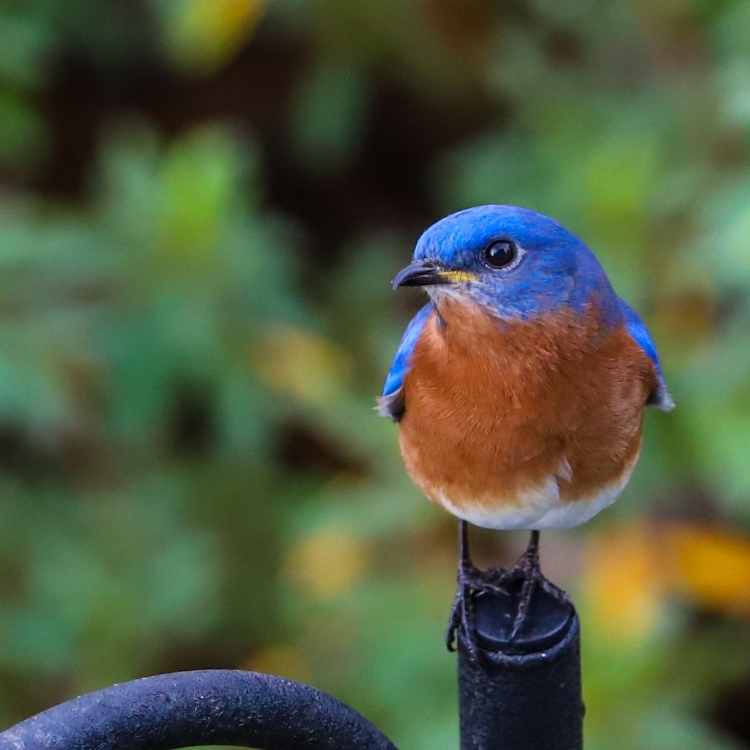The human eye usually overlooks minute characteristics that identify one bird from another. This optical illusion sometimes mystifies people who watch birds in flight. The Bluebird and Blue Jay are two of the most usually misunderstood birds owing to their similar look. The objective of this post/article is to train human eyes on how to notice such minute distinctions and accurately identify the bird in front of them in order to develop into an experienced birdwatcher!

Table of Contents
- 1 Differences
- 2
- 3 Similarities between Bluebird vs Blue Jay
- 4 Interesting facts about Bluebird
- 5 Interesting facts about Blue Jay
- 6 Final Verdict
- 7 Frequently Asked Questions
- 7.1 What are the main physical differences between a bluebird and a blue jay?
- 7.2 How can I identify a blue jay by its crest?
- 7.3 Where do bluebirds and blue jays live geographically?
- 7.4 What’s the difference in their mating and breeding habits?
- 7.5 How do their flight speeds and patterns differ?
- 7.6 What sounds do bluebirds and blue jays make?
- 7.7 What do bluebirds and blue jays eat?
- 7.8 Why do blue jays imitate hawk sounds?
- 7.9 What is sexual monomorphism in blue jays?
- 7.10 How far can bluebirds detect insects for hunting?
Differences
Appearance
If you like the color blue, either of these birds will appeal to you (see more birds that are blue). The eastern and western bluebirds both have vivid blue plumage that contrasts with a reddish-brown breast, and both are considered to be endangered. The male mountain bluebird is distinguished by its sky blue body, head, and wings, as well as its white belly. Unlike the male, the female has a more subtle coloration, with a brownish tone blended with blue covering her whole body. The length of a bluebird is between 6.5 and 8.5 inches.
On the other hand, the blue jay is bigger, with a wingspan ranging from 10 to 12 inches. Unlike the Bluebird, he has a white or gray breast that is crowned with blue plumage, making him showier. His distinctive crest on his head also helps to distinguish him from the crowd.

Habitat
The blue bird’s name specifies where he can be found; the eastern version can be found east of the Rockies, spanning from Canada to Honduras, while the western form can be found west of the Rockies, spanning from Canada to Mexico. The mountain blue bird’s range extends into the eastern and western blue bird’s territories. The mountain bluebird may be found in agricultural regions and tree groves, but the western Bluebird prefers open forests. The Eastern Bluebird may be found in open land with trees and is prevalent in pastures, suburban parks, backyards, and fields.
Compared to all Bluebird species, the blue jay may be found throughout most North America, with its range steadily expanding into Northwest America. He may be found in woods — though he favors forest margins over the deep forest — as well as urban and suburban regions, according to his preferences. Oak trees and bird feeders are among his favorite landscaping features.
Behavior
All bluebirds have the ability to mate more than once throughout the course of the year. The Eastern Bluebird lays two to seven eggs in a clutch, which hatches in two to three weeks and can live for up to three years. Unlike the mountain bluebird, which has a bigger clutch ranging from four to eight eggs, the western blue bird’s clutch ranges from two to eight eggs, depending on the size of the nest. When compared to its eastern cousin, the hatching time for their eggs is around two to three weeks. While t the blue jay only mates once a year and produces a clutch of two to seven eggs, which she will incubate for about three weeks before hatching them.

Diet
Despite their preference for insects, all three bluebirds will consume fruits such as blueberries, raspberries, and currants. Spiders, caterpillars, beetles, and crickets are among the insects that make up these birds’ staple food. On the contrary, blue jay has a reputation for being a thief of food; however, this is mostly incorrect in the majority of cases. Instead of stealing nests for eggs or nestlings, this chap likes to eat nuts and seeds, which he gets from various sources. He will consume insects such as grasshoppers and beetles, as well as other small invertebrates.
Some other notable differences between Bluebird vs Blue Jay
| Bluebird | Blue Jay |
|---|---|
| Make a Low-pitched, warbling song of several notes | Produce whispering tone, clicks, whirrs, chucks, whines, and liquid notes |
| The tail is short and narrow | The tail is long and wide |
| Flight speed is 17-18 miles per hour | Flight speed is 22-25 miles per hour |
| Norma; flock size is 8-100 | Normal flock size is 6-250 |
| More prevalent in Central, Southwestern, and Northern United States | Usually found in Western North America. |
| A little smaller than Blay Jay with size ranging from 6.5-8 inches | A little larger than Bluebird with size ranging from 10-11.8 inches |

Similarities between Bluebird vs Blue Jay
Many similarities exist between the two species, such as the fact that they both have varying degrees of blue plumage and that they are both Omnivores, which means that they consume both plants and insects.
Furthermore, both the Bluebird and the Blue Jay are considered to be singers. They both have beautiful voices and appealing music. Both bird species have extraordinarily fast flying speeds, and people are fascinated by them.
Interesting facts about Bluebird
Bluebirds, including the eastern, western, and mountain bluebirds, are distributed across North America. All bluebirds nest in cavities and will use a man-made nest box. For many years, habitat and nest cavities were dwindling, but bluebirds have made a remarkable recovery due to the installation of thousands of bluebird nest boxes across the country.
March to August is the nesting season of Bluebird. The female alone incubates the four to six eggs, which she keeps at 98 to 100 degrees Fahrenheit until hatching.
Other interesting facts
- A bluebird can detect caterpillars and insects in thick grass from an astonishing distance of more than 50 yards.
- Both sexes defend territories; however, males are more concerned with defending territorial margins, and females are more concerned with defending the nest site.
- Males may transport nest material to the nest, but they do not assist in its construction. They devote considerable time to defending their partners throughout this time period in order to prevent them from mating with other males.
- Read more about the bluebird meaning.
Here you can check all Bluebird sounds
Interesting facts about Blue Jay
Blue Jays can generate a wide range of noises, and it is typical to hear them imitating hawks, particularly the Red-shouldered Hawk. According to ornithologists, they do so for one of two reasons. The first is that the imitation serves as a warning to other jays regarding the presence of any lurking hawks. The second reason is that jays are attempting to deceive other species into believing that hawks are around.
Other Blue Jay Facts
- Male and female blue jays are identical in appearance! This is a somewhat uncommon occurrence in birds and is referred to as sexual monomorphism. Males and females of most bird species look quite different from one another, which is referred to as sexual dimorphism (read more about the blue jay feather).
- The Blue Jays are a pack of birds. They are extremely cooperative with other members of their species, and a group of jays will frequently chase away other birds from “their” feeders.
- Originally, a jay was a noisy, impertinent person who dominated talks. Blue Jays were given their name due to their tendency to be boisterous, vibrant, and active.
- Check also our post about the blue jay symbolism.
Here you can check all Blue Jay sounds
Final Verdict
Bluebirds and blue jays have significant distinctions. Bluebirds are well-known for their low-pitched, warbling songs, while Blue Jays are known for whispering tones, clicks, whirrs, chucks, and whines. The other important thing is that most blue jays have crests on their heads, whereas bluebirds have smaller beaks and tails.
In case you’re interested in further reading – we also compared the cardinal vs blue jay.
Frequently Asked Questions
What are the main physical differences between a bluebird and a blue jay?
Bluebirds measure 6.5–8.5 inches with reddish-brown breasts and short tails, while blue jays are larger at 10–12 inches with white or gray breasts and distinctive head crests. Blue jays also have longer, wider tails and showier blue plumage overall.
How can I identify a blue jay by its crest?
Blue jays have a prominent, pointed crest on their heads that raises when alert or agitated. This distinctive feature is one of the easiest ways to identify them instantly. Bluebirds lack this crest entirely, making it a reliable identification marker.
Where do bluebirds and blue jays live geographically?
Eastern bluebirds inhabit areas east of the Rockies from Canada to Honduras, while western bluebirds prefer open forests west of the Rockies. Blue jays range throughout most of North America with expanding presence in Northwest America, adapting to forests, suburbs, and urban areas.
What’s the difference in their mating and breeding habits?
Bluebirds mate multiple times yearly, producing 2–8 eggs per clutch with 2–3 week incubation periods. Blue jays mate once annually, laying 2–7 eggs incubated for about three weeks. Both species nest in cavities and use artificial nest boxes successfully.
How do their flight speeds and patterns differ?
Bluebirds fly at 17–18 miles per hour with short, narrow tails, while blue jays reach 22–25 miles per hour with longer, wider tails. Blue jays demonstrate more agile, faster flight patterns, whereas bluebirds maintain steadier, more deliberate flying speeds.
What sounds do bluebirds and blue jays make?
Bluebirds produce low-pitched, warbling songs with several musical notes, while blue jays create whispering tones, clicks, whirrs, chucks, and whines. Blue jays can imitate hawk calls convincingly, whereas bluebirds maintain consistent melodic patterns.
What do bluebirds and blue jays eat?
Both species are omnivores eating insects like caterpillars, beetles, and crickets. Bluebirds prefer berries like blueberries and raspberries. Blue jays favor nuts and seeds from multiple sources, plus grasshoppers and small invertebrates, rarely stealing from nests.
Why do blue jays imitate hawk sounds?
Blue jays mimic hawk calls, particularly red-shouldered hawks, for two reasons: warning other jays about predators or deceiving other bird species into believing hawks are present. This sophisticated vocal behavior helps protect their community and feeding territories effectively.
What is sexual monomorphism in blue jays?
Sexual monomorphism means male and female blue jays look virtually identical, unlike most bird species showing sexual dimorphism where genders appear different. This rarity makes blue jays unique among commonly observed North American birds.
How far can bluebirds detect insects for hunting?
Bluebirds possess remarkable vision, detecting caterpillars and insects in thick grass from distances exceeding 50 yards away. This exceptional eyesight enables them to hunt effectively from perches, demonstrating sophisticated predatory adaptations superior to most songbirds.



